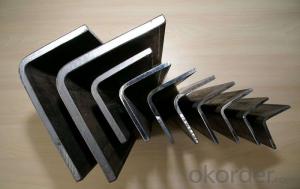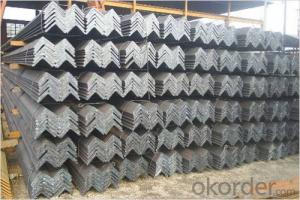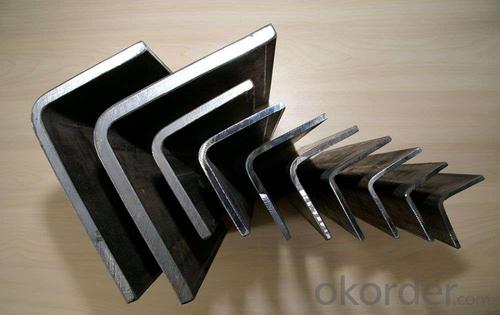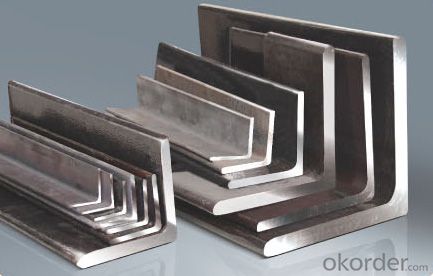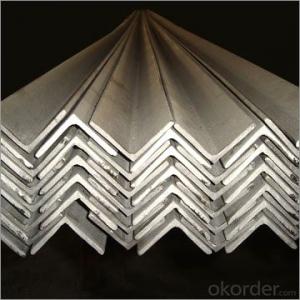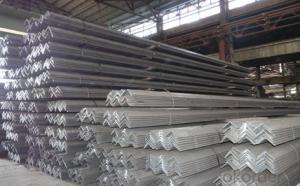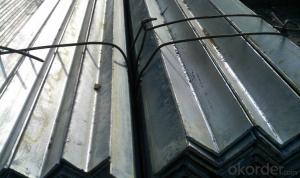GB Equal Unequal Angle Steel, Stainless Steel Angle, Steel Angle Iron Weights
- Loading Port:
- Tianjin
- Payment Terms:
- TT or LC
- Min Order Qty:
- 27 m.t.
- Supply Capability:
- 24000 m.t./month
OKorder Service Pledge
Quality Product, Order Online Tracking, Timely Delivery
OKorder Financial Service
Credit Rating, Credit Services, Credit Purchasing
You Might Also Like
Product Specifications of GB Equal Unequal Angle Steel, Stainless Steel Angle, Steel Angle Iron Weights
GB unequal angle steel
unequal angle steel
material:Q235 Q345
size: 20*3-200*24 or 25*16-200*125(mm)
stainless unequal angle
Detail Information of GB Equal Unequal Angle Steel, Stainless Steel Angle, Steel Angle Iron Weights
1)Tolerance: +/-5% (thickness,length,weight)
2)Certification: Mill Certification
3)Price term: FOB or CFR according to clients requirements
4))Use:shipbuilding,steel tower,construction,electric utility industry
A:Unequal angle bars:25*16*3--200*125*18(mm)
B:Equal angle bars
| Equal angle steel | |||||||
| Size | Width (mm | Thicknessmm) | Density (kg/m) | Size | Width (mm | Thicknessmm) | Density (kg/m) |
| 20 | 20 | 3 | 0.889 | 80 | 80 | 7 | 8.525 |
| 20 | 20 | 4 | 1.145 | 80 | 80 | 8 | 9.658 |
| 25 | 25 | 3 | 1.124 | 80 | 80 | 10 | 11.874 |
| 25 | 25 | 4 | 1.459 | 90 | 90 | 6 | 8.35 |
| 30 | 30 | 3 | 1.373 | 90 | 90 | 7 | 9.656 |
| 30 | 30 | 4 | 1.786 | 90 | 90 | 8 | 10.946 |
| 35 | 35 | 3 | 1.578 | 90 | 90 | 10 | 13.476 |
| 35 | 35 | 4 | 2.072 | 90 | 90 | 12 | 15.94 |
| 35 | 35 | 5 | 2.551 | 100 | 100 | 6 | 9.366 |
| 40 | 40 | 3 | 1.852 | 100 | 100 | 7 | 10.83 |
| 40 | 40 | 4 | 2.422 | 100 | 100 | 8 | 10.276 |
| 40 | 40 | 5 | 1.976 | 100 | 100 | 10 | 15.12 |
| 44 | 44 | 3 | 2.002 | 100 | 100 | 12 | 17.898 |
| 44 | 44 | 4 | 2.638 | 100 | 100 | 14 | 20.611 |
| 38 | 38 | 3 | 1.719 | 100 | 100 | 16 | 23.257 |
| 38 | 38 | 4 | 2.261 | 110 | 110 | 7 | 11.928 |
| 48 | 48 | 3 | 2.19 | 110 | 110 | 8 | 13.532 |
| 48 | 48 | 4 | 2.889 | 110 | 110 | 10 | 16.69 |
| 48 | 48 | 5 | 3.572 | 110 | 110 | 12 | 19.782 |
| 50 | 50 | 3 | 2.332 | 110 | 110 | 14 | 22.809 |
| 50 | 50 | 4 | 3.059 | 125 | 125 | 8 | 15.504 |
| 50 | 50 | 5 | 3.77 | 125 | 125 | 10 | 19.133 |
| 50 | 50 | 6 | 4.465 | 125 | 125 | 12 | 22.692 |
| 56 | 56 | 3 | 2.624 | 125 | 125 | 14 | 26.193 |
| 56 | 56 | 4 | 3.446 | 140 | 140 | 10 | 21.488 |
| 56 | 56 | 5 | 4.251 | 140 | 140 | 12 | 25.522 |
| 56 | 56 | 6 | 6.568 | 140 | 140 | 14 | 29.49 |
| 63 | 63 | 4 | 3.907 | 140 | 140 | 16 | 33.393 |
| 63 | 63 | 5 | 4.822 | 160 | 160 | 10 | 24.724 |
| 63 | 63 | 6 | 5.721 | 160 | 160 | 12 | 29.391 |
| 63 | 63 | 8 | 7.469 | 160 | 160 | 14 | 33.987 |
| 63 | 63 | 10 | 9.151 | 160 | 160 | 16 | 38.518 |
| 70 | 70 | 4 | 4.372 | 180 | 180 | 12 | 33.159 |
| 70 | 70 | 5 | 5.397 | 180 | 180 | 14 | 35.383 |
| 70 | 70 | 6 | 6.406 | 180 | 180 | 16 | 43.452 |
| 70 | 70 | 7 | 7.398 | 180 | 180 | 18 | 48.634 |
| 70 | 70 | 8 | 8.373 | 200 | 200 | 14 | 42.894 |
| 75 | 75 | 5 | 5.818 | 200 | 200 | 16 | 48.56 |
| 75 | 75 | 6 | 6.905 | 200 | 200 | 18 | 54.501 |
| 75 | 75 | 7 | 7.976 | 200 | 200 | 20 | 60.056 |
| 75 | 75 | 8 | 9.03 | 200 | 200 | 22 | 71.168 |
| 75 | 75 | 10 | 11.089 | Length=6-12meters SS400 or Q235 | |||
| 80 | 80 | 5 | 6.211 | ||||
| 80 | 80 | 6 | 7.376 | ||||
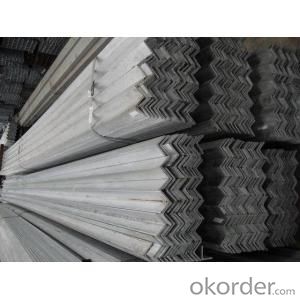
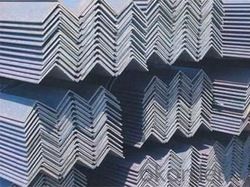

- Q: Can steel angles be used in outdoor or corrosive environments?
- Yes, steel angles can be used in outdoor or corrosive environments. However, it is important to choose the right type of steel that is specifically designed to withstand corrosion and other environmental factors. Stainless steel angles, for example, are commonly used in such environments due to their high resistance to rust and corrosion. Regular carbon steel angles, on the other hand, may require additional protective coatings or treatments to prevent corrosion in outdoor or corrosive environments.
- Q: What are the different types of steel angles used in agriculture?
- There are several different types of steel angles used in agriculture, each with its own unique purpose and function. One common type is the standard angle, which is typically used for general construction and support applications. These angles have a 90-degree bend and are often used to reinforce structures such as barns, fences, and gates. Another type is the corner angle, which is specifically designed for creating corners or joints in agricultural structures. These angles have equal legs and are typically used to provide additional strength and stability at the corners of buildings, enclosures, or equipment. Slotted angles are also commonly used in agriculture. These angles have pre-drilled holes along their length, allowing for easy attachment of various components such as shelves, brackets, or hooks. They are often used in storage areas or workshops to create custom shelving or storage solutions. Additionally, there are specialized steel angles used for specific agricultural applications. For example, rack angles are used to support and secure storage racks for hay or other agricultural products. Purlin angles are used to support roof structures or provide additional strength to roof trusses in agricultural buildings. Overall, the different types of steel angles used in agriculture serve various purposes, including structural support, reinforcement, joint creation, and customized storage solutions. The specific type of angle used will depend on the specific requirements and needs of the agricultural project or structure.
- Q: What are the different methods of surface painting for steel angles?
- There are several different methods of surface painting for steel angles, each offering unique benefits and considerations. 1. Brushing: This is the most common method of surface painting for steel angles. It involves using a paintbrush to manually apply paint onto the surface. Brushing allows for good control and precision, making it ideal for smaller projects or touch-ups. However, it may not be as efficient for large-scale applications. 2. Spraying: Spraying is a popular method for painting steel angles, especially when a large area needs to be covered quickly. It involves using a paint spray gun or aerosol canister to evenly distribute paint onto the surface. Spraying allows for a smooth and uniform finish, but it requires appropriate safety precautions, such as wearing a mask and ensuring proper ventilation. 3. Dipping: Dipping involves immersing the steel angles in a tank or container filled with paint. This method ensures complete coverage and is often used for high-volume production processes. However, it may not be suitable for complex shapes or angles with intricate designs, as the excess paint may drip or accumulate unevenly. 4. Electrostatic painting: Electrostatic painting is a method that involves charging the paint particles and applying them to a grounded steel angle. This creates an electromagnetic attraction, resulting in a more even and efficient coverage. Electrostatic painting is commonly used in industrial settings and can help reduce paint waste and overspray. 5. Powder coating: Powder coating is a dry finishing process that involves applying a fine powder onto the steel angle's surface. The powder is then heated and fused onto the metal, creating a durable and attractive finish. Powder coating provides excellent corrosion resistance and can be done in a variety of colors and textures. However, it requires specialized equipment and may not be suitable for small-scale or on-site applications. When selecting a method of surface painting for steel angles, it is important to consider factors such as the size and complexity of the project, desired finish quality, environmental conditions, and available resources. Consulting with a professional painter or coating specialist can help determine the most suitable method for a specific application.
- Q: What is the typical yield stress of steel angles?
- The typical yield stress of steel angles can vary depending on the specific grade and thickness of the angle, but it generally falls within the range of 36,000 to 50,000 pounds per square inch (psi).
- Q: What are the different methods of corrosion protection for steel angles?
- Steel angles can be protected from corrosion through various methods, each having its own advantages and disadvantages. 1. Protective coatings are commonly used to safeguard steel angles. These coatings include paint, epoxy, and galvanization. Paint creates a barrier that prevents moisture and oxygen from reaching the steel surface. Epoxy coatings offer a more robust layer, providing enhanced corrosion protection. Galvanization involves applying a zinc layer to act as sacrificial protection, corroding before the steel. 2. Cathodic Protection utilizes an external electrical current to safeguard steel angles. By connecting the steel to a more easily corroded metal, such as zinc or magnesium, and applying direct current, the less noble metal corrodes instead of the steel. This method is beneficial in marine or underground environments. 3. Alloying can also protect steel angles from corrosion. By adding small amounts of metals like chromium or nickel to the steel composition, the resulting alloy forms a protective oxide layer on the surface, preventing further corrosion. Stainless steel is an excellent example of an alloy with high corrosion resistance. 4. Barrier Films create a physical barrier on the steel surface to prevent corrosion. This method involves applying films like polyethylene or PVC, which block moisture and oxygen from reaching the steel. It is commonly used in environments with harsh conditions or chemicals. 5. Environmental Control is another way to prevent corrosion. By controlling the environment in which the steel angles are placed, exposure to moisture, humidity, and corrosive chemicals can be minimized. Proper ventilation, regular cleaning, and maintaining a dry environment contribute to corrosion prevention. It is important to consider several factors, such as the specific application, environmental conditions, and budget constraints, to determine the most suitable corrosion protection method for steel angles. Consulting corrosion experts or engineers is recommended for a tailored approach.
- Q: Can steel angles be used in railway track construction?
- Yes, steel angles can be used in railway track construction. Steel angles are often used as a structural component in the construction of railway tracks. They provide strength and stability to the track system, helping to support the weight of the train and distribute the load evenly. Steel angles are commonly used for the construction of rail joints, which connect two sections of rail together, as well as for the installation of rail fastenings and track accessories. They are durable, resistant to wear, and can withstand heavy loads and high impact forces, making them an ideal choice for railway track construction.
- Q: How do you calculate the moment resistance of a steel angle?
- To calculate the moment resistance of a steel angle, you need to consider the geometry and material properties of the angle. The moment resistance refers to the ability of the angle to withstand bending forces. First, you need to determine the section modulus, which is a measure of the shape's resistance to bending. The section modulus can be calculated by taking the moment of inertia of the angle (I) and dividing it by the distance from the centroid of the shape to the furthest point (c). Next, you need to determine the yield strength of the steel angle. This is the point at which the material starts to deform permanently. The yield strength is typically provided by the manufacturer or can be obtained from material testing. Finally, the moment resistance can be calculated by multiplying the section modulus (Z) by the yield strength (σ). This gives you the maximum moment the steel angle can resist before it starts to deform permanently. Moment Resistance = Z * σ It is important to note that this calculation assumes the steel angle is subjected to pure bending. If there are additional factors such as axial or shear forces, additional calculations or considerations may be required. Additionally, it is always recommended to consult relevant design codes or engineering handbooks for more accurate and detailed calculations.
- Q: Can steel angles be used for support structures in telecommunications installations?
- Yes, steel angles can be used for support structures in telecommunications installations. Steel angles are commonly used in construction and engineering applications due to their strength and durability. They provide excellent support and can withstand heavy loads and harsh environmental conditions. In telecommunications installations, steel angles are often used for mounting antennas, satellite dishes, and other equipment. They offer a stable and secure platform for the installation of telecommunications infrastructure, ensuring reliable and efficient communication networks. Additionally, steel angles can be easily customized and fabricated to meet specific design requirements, making them a versatile choice for support structures in telecommunications installations.
- Q: Are steel angles suitable for corrosive environments?
- Steel angles can be suitable for corrosive environments, depending on the specific conditions and the type of steel used. Stainless steel angles, for example, are highly resistant to corrosion due to the high levels of chromium and nickel in their composition. They are often used in environments where there is exposure to moisture, chemicals, or saltwater, such as marine applications or industrial settings. However, carbon steel angles may not be as suitable for corrosive environments as they are more prone to rust and corrosion. In such cases, additional protective measures such as coatings or galvanization may be necessary to enhance their resistance to corrosion. It is important to consider the specific corrosive elements present in the environment, the level of exposure, and the required longevity of the steel angles. Consulting with a corrosion specialist or an engineer experienced in materials selection can help determine the most suitable steel angles for corrosive environments.
- Q: Are steel angles resistant to earthquakes?
- Seismic-resistant construction can be achieved by utilizing steel angles, which possess high strength and ductility, making them suitable for this purpose. Often referred to as steel L-shaped beams, these steel angles are commonly employed in structural applications to provide support and reinforcement. During an earthquake, the utilization of steel angles aids in the even distribution of seismic forces throughout the structure, thereby reducing the occurrence of concentrated stress points. The L-shape design of these steel angles allows them to effectively resist bending and twisting forces, which are frequently encountered during seismic events. Moreover, steel angles can be interconnected and welded together to establish a rigid frame system, thereby enhancing their capability to withstand seismic forces. Such a system effectively absorbs and dissipates energy resulting from vibrations caused by earthquakes, ultimately minimizing any potential damage inflicted upon the structure. Nevertheless, it is crucial to acknowledge that the overall seismic resistance of a structure is contingent upon several factors, including its design, construction methods, and adherence to building codes and regulations. While steel angles alone cannot ensure complete protection against earthquakes, their integration into a well-designed seismic-resistant system significantly augments the structure's capacity to withstand seismic forces.
Send your message to us
GB Equal Unequal Angle Steel, Stainless Steel Angle, Steel Angle Iron Weights
- Loading Port:
- Tianjin
- Payment Terms:
- TT or LC
- Min Order Qty:
- 27 m.t.
- Supply Capability:
- 24000 m.t./month
OKorder Service Pledge
Quality Product, Order Online Tracking, Timely Delivery
OKorder Financial Service
Credit Rating, Credit Services, Credit Purchasing
Similar products
Hot products
Hot Searches
Related keywords
